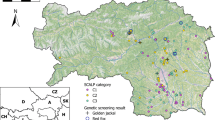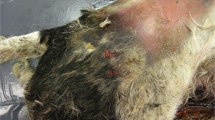Abstract
Predation on livestock is a cause of serious and long-lasting conflict between farmers and wildlife, promoting negative public attitudes and endangering conservation of large carnivores. However, while large carnivores, especially the grey wolf (Canis lupus), are often blamed for killing sheep and other farm animals, free-ranging dogs may also act as predators. To develop appropriate measures for livestock protection, reliable methods for identifying predator species are critical. Identification of predators from visual examination of livestock wounds can be ambiguous and genetic analysis is strongly preferable for accurate species determination. To estimate the proportion of wolves and dogs implicated in sheep predation, we developed a sensitive genetic assay to distinguish between wolves and domestic dogs. A total of 183 predator saliva samples collected from killed sheep in Estonia were analysed. The assay identified the predator species in 143 cases (78%). Sheep were most often killed by wolves (81%); however, predation by dogs was substantial (15%). We compared the molecular results with field observations conducted by local environmental officials and recorded some disagreement, with the latter underestimating the role of dogs. As predator saliva samples collected from prey are often of poor quality, we suggest using mitochondrial DNA as a primary tool to maximise the number of successfully analysed samples. We also suggest adopting forensic DNA analysis more widely in livestock predation assessments as a legislative measure since misidentification that is biased against wolves can be counterproductive for conservation by enhancing conflict with society and leading to increased culling and poaching.


Similar content being viewed by others
References
Blejwas KM, Williams CL, Shin GT, McCullough DR, Jaeger MM (2006) Salivary DNA evidence convicts breeding male coyotes of killing sheep. J Wildl Manag 70:1087–1093
Boitani L, Ciucci P, Raganella-Pelliccioni E (2010) Ex-post compensation payments for wolf predation on livestock in Italy: a tool for conservation? Wildl Res 37:722–730. https://doi.org/10.1071/WR10029
Boitani L et al (2015) Key actions for large carnivore populations in Europe. Institute of Applied Ecology (Rome, Italy). Report to DG Environment, European Commission, Bruxelles. Contract no. 07.0307/2013/654446/SER/B3
Bradley EH, Robinson HS, Bangs EE, Kunkel K, Jimenes MD, Gude JA, Grimm T (2015) Effects of wolf removal on livestock depredation recurrence and wolf recovery in Montana, Idaho, and Wyoming. J Wildl Manag 79:1337–1346. https://doi.org/10.1002/jwmg.948
Browne-Nuñez C, Treves A, MacFarland D, Voyles Z, Turng C (2015) Tolerance of wolves in Wisconsin: a mixed-methods examination of policy effects on attitudes and behavioral inclinations. Biol Conserv 189:59–71. https://doi.org/10.1016/j.biocon.2014.12.016
Caniglia R, Fabbri E, Mastrogiuseppe L, Randi E (2013) Who is who? identification of livestock predators using forensic genetic approaches. Forensic Sci Int Genet 7:397–404. https://doi.org/10.1016/j.fsigen.2012.11.001
Chapron G, Treves A (2016) Blood does not buy goodwill: allowing culling increases poaching of a large carnivore. Proc R Soc B 283:20152939. https://doi.org/10.1098/rspb.2015.2939
Chapron G et al (2014) Recovery of large carnivores in Europe’s modern human-dominated landscapes. Science 346:1517–1519. https://doi.org/10.1126/science.1257553
Dondina O, Meriggi A, Dagradi V, Perversi M, Milanesi P (2015) Wolf predation on livestock in an area of northern Italy and prediction of damage risk. Ethol Ecol Evol 27:200–219. https://doi.org/10.1080/03949370.2014.916352
Echegaray J, Vilá C (2010) Noninvasive monitoring of wolves at the edge of their distribution and the cost of their conservation. Anim Conserv 13:157–161. https://doi.org/10.1111/j.1469-1795.2009.00315.x
Eklund A, López-Bao JV, Tourani M, Chapron G, Frank J (2017) Limited evidence on the effectiveness of interventions to reduce livestock predation by large carnivores. Sci Rep 7:2097. https://doi.org/10.1038/s41598-017-02323-w
Estes JA et al (2011) Trophic downgrading of planet earth. Science 333:301–306. https://doi.org/10.1126/science.1205106
Fabbri E, Caniglia R, Kusak J, Galov A, Gomerčić T, Arbanasić H, Huber D, Randi E (2014) Genetic structure of expanding wolf (Canis lupus) populations in Italy and Croatia, and the early steps of the recolonization of the Eastern Alps. Mamm Biol 79:138–148. https://doi.org/10.1016/j.mambio.2013.10.002
Fernández-Gil A, Naves J, Ordiz A, Quevedo M, Revilla E, Delibes M (2016) Conflict misleads large carnivore management and conservation: brown bears and wolves in Spain. PLoS ONE 11(3):e0151541. https://doi.org/10.1371/journal.pone.0151541
Hall TA (1999) BioEdit: a user-friendly biological sequence alignment editor and analysis program for Windows 95/98/NT. Nucl Acid Symp Ser 41:95–98
Harms V, Nowak C, Carl S, Muños-Fuentes V (2015) Experimental evaluation of genetic predator identification from saliva traces on wildlife kills. J Mamm 96:138–143. https://doi.org/10.1093/jmammal/gyu014
Hindrikson M, Männil P, Ozolins J, Krzywinski A, Saarma U (2012) Bucking the trend in wolf-dog hybridization: first evidence from Europe of hybridization between female dogs and male wolves. PLoS ONE 7(10):e46465. https://doi.org/10.1371/journal.pone.0046465
Hindrikson M et al (2017) Wolf population genetics in Europe: a systematic review, meta-analysis and suggestions for conservation and management. Biol Rev 92:1601–1629. https://doi.org/10.1111/brv.12298
Hughes J, Macdonald DW (2013) A review of the interactions between free-roaming domestic dogs and wildlife. Biol Conserv 157:341–351. https://doi.org/10.1016/j.biocon.2012.07.005
Jerina K, Adamič M (2008) Fifty years of brown bear population expansion: effects of sex-biased dispersal on rate of expansion and population structure. J Mamm 89:1491–1501
Johnson RN, Wilson-Wilde L, Linacre A (2014) Current and future directions of DNA in wildlife forensic science. Forensic Sci Int Genet 20:1–11. https://doi.org/10.1016/j.fsigen.2013.12.007
Kaartinen S, Luoto M, Kojola I (2009) Carnivore-livestock conflicts: determinants of wolf (Canis lupus) depredation on sheep farms in Finland. Biodivers Conserv 18:3503. https://doi.org/10.1007/s10531-009-9657-8
Kaczensky P, Chapron G, von Arx M, Huber D, Andren H, Linnell J (2012) Status, management and distribution of large carnivores—bear, lynx, wolf & wolverine—in Europe. European Commission
Karlsson J, Sjöström M (2011) Subsidized fencing of livestock as a means of increasing tolerance for wolves. Ecol Soc 16:16
Koepfli KP et al (2015) Genome-wide evidence reveals that African and Eurasian golden jackals are distinct species. Curr Biol 25:2158–2165. https://doi.org/10.1016/j.cub.2015.06.060
Krofel M, Giannatos G, Ćirović D, Stoyanov S, Newsome TM (2017) Golden jackal expansion in Europe: a case of mesopredator release triggered by continent-wide wolf persecution? Hystrix. https://doi.org/10.4404/hystrix-28.1-11819
Liberg O, Chapron G, Wabakken P, Pedersen HC, Thompson Hobbs N, Sand H (2011) Shoot, shovel and shut up: cryptic poaching slows restoration of a large carnivore in Europe. Proc R Soc B 279:910–915. https://doi.org/10.1098/rspb.2011.1275
Linnell J, Salvatori V, Boitani L (2008) Guidelines for population level management plans for large carnivores in Europe. A large carnivore initiative for Europe report prepared for the European Commission (contract 070501/2005/424162/MAR/B2)
López-Bao JV, Frank J, Svensson L, Åkesson M, Langefors Å (2017) Building public trust in compensation programs through accuracy assessments of damage verification protocols. Biol Conserv 213:36–41. https://doi.org/10.1016/j.biocon.2017.06.033
Milanesi P, Caniglia R, Fabbri E, Galaverni M, Meriggi A, Randi E (2015) Non-invasive genetic sampling to predict wolf distribution and habitat suitability in the Northern Italian Apennines: implications for livestock depredation risk. Eur J Wildl Res 61:681–689. https://doi.org/10.1007/s10344-015-0942-4
Mumma MA, Soulliere CE, Mahoney SP, Waits LP (2014) Enhanced understanding of predator–prey relationships using molecular methods to identify predator species, individual and sex. Mol Ecol Resour 14:100–108. https://doi.org/10.1111/1755-0998.12153
Neale JCC, Sacks BN, Jager MM, McCullough DR (1998) A comparison of bobcat and coyote predation on lambs in north-coastal California. J Wildl Manag 62:700–706
Plumer L, Keis M, Remm J, Hindrikson M, Jõgisalu I, Männil P, Kübarsepp M, Saarma U (2016) Wolves recolonizing islands: genetic consequences and implications for conservation and management. PLoS ONE 11(7):e0158911. https://doi.org/10.1371/journal.pone.0158911
Pohja-Mykrä M, Kurki S (2014) Strong community support for illegal killing challenges wolf management. Eur J Wildl Res 60:759–770. https://doi.org/10.1007/s10344-014-0845-9
Poudyal N, Baral N, Asah ST (2016) Wolf lethal control and livestock depredations: counter-evidence from respecified models. PLoS ONE 11(2):e0148743. https://doi.org/10.1371/journal.pone.0148743
Rigg R, Finďo S, Wechselberger M, Gorman ML, Sillero-Zubiri C, Macdonald DW (2011) Mitigating carnivore–livestock conflict in Europe: lessons from Slovakia. Oryx 45:272–280. https://doi.org/10.1017/S0030605310000074
Schaeffer JM, Andrews RD, Dinsmore JJ (1981) An assessment of coyote and dog predation on sheep in Southern Iowa. J Wildl Manag 45:883–893
Sindičić M, Gomerčić T, Galov A, Arbanasić H, Kusak J, Slavica A, Huber Đ (2011) Mitochondrial DNA control region as a tool for species identification and distinction between wolves and dogs from Croatia. Vet Arh 81:249–258
St John FAV, Keane AM, Edwards-Jones G, Jones L, Yarnell RW, Jones JPG (2012) Identifying indicators of illegal behavior: carnivore killing in human-managed landscapes. Proc R Soc B 279:804–812. https://doi.org/10.1098/rspb.2011.1228
Sundqvist KA, Ellegren H, Vilá C (2008) Wolf or dog? genetic identification of predators from saliva collected around bite wounds on prey. Conserv Genet 9:1275. https://doi.org/10.1007/s10592-007-9454-4
Szabó L, Heltai M, Lanszki J (2010) Jackal versus livestock—is it a real problem? Hung Agric Res 19:4–10
Talvi T (2014) Looma tekitatud kahjustuse ennetamine. Estonian Environmental Board, Tallinn (In Estonian)
Treves A, Bruskotter J (2014) Tolerance for predatory wildlife. Science 344:476–477. https://doi.org/10.1126/science.1252690
Treves A, Martin KA, Wydeven AP, Wiedenhoeft JE (2011) Forecasting environmental hazards and the application of risk maps to predator attacks on livestock. Bioscience 61:451–458. https://doi.org/10.1525/bio.2011.61.6.7
Treves A, Naughton-Treves L, Shelley V (2013) Longitudinal analysis of attitudes toward wolves. Conserv Biol 27:315–323. https://doi.org/10.1111/cobi.12009
Treves A, Krofel M, McManus J (2016) Predator control should not be a shot in the dark. Front Ecol Environ 14:380–388. https://doi.org/10.1002/fee.1312
Trouwborst A, Krofel M, Linnell JDC (2015) Legal implications of range expansions in a terrestrial carnivore: the case of the golden jackal (Canis aureus) in Europe. Biodivers Conserv 24:2593–2610. https://doi.org/10.1007/s10531-015-0948-y
Veeroja R, Männil P (2016) Status of game populations in Estonia and proposal for hunting in 2016. Estonian Environment Agency, Tallinn (In Estonian)
Wielgus RB, Peebles KA (2014) Effects of wolf mortality on livestock depredations. PLoS ONE 9(12):e113505. https://doi.org/10.1371/journal.pone.0113505
Acknowledgements
We thank John Davison for language revision and three anonymous reviewers for valuable comments and suggestions. We are grateful to all who helped in fieldwork. This work was supported by institutional research funding (IUT20-32) from the Estonian Ministry of Education and Research, and the Estonian Environmental Investment Centre.
Author information
Authors and Affiliations
Corresponding author
Ethics declarations
Conflict of interest
The authors declare that they have no conflicts of interest.
Electronic supplementary material
Below is the link to the electronic supplementary material.
Rights and permissions
About this article
Cite this article
Plumer, L., Talvi, T., Männil, P. et al. Assessing the roles of wolves and dogs in livestock predation with suggestions for mitigating human–wildlife conflict and conservation of wolves. Conserv Genet 19, 665–672 (2018). https://doi.org/10.1007/s10592-017-1045-4
Received:
Accepted:
Published:
Issue Date:
DOI: https://doi.org/10.1007/s10592-017-1045-4




